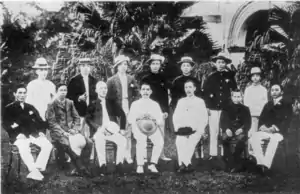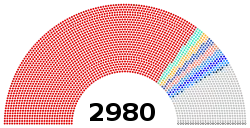List of political parties in China
China, officially the People's Republic of China, is formally a multi-party state under the leadership of the Chinese Communist Party (CCP) leading eight minor parties, in a United Front similar to the popular fronts of former Communist-era Eastern European countries such as the National Front of Czechoslovakia or National Front of German Democratic Republic.
.svg.png.webp) |
|---|
| This article is part of a series on the politics and government of China |
|
|
Under the one country, two systems system, the special administrative regions of Hong Kong and Macau, which were previously colonies of European powers, operate under a different political system to the rest of China. Currently, both Hong Kong and Macau possess multi-party systems that were introduced just before the handover of the territories to China.[1]
Relationships with the Chinese Communist Party
In practice, only one political party holds effective power at the national level, namely the CCP. Its dominance is such that China is effectively a one-party state. The eight minor parties are part of the United Front and also take part in the political system, but they have limited power at national level.[2][3] The minor parties must accept the "leading role" of the CCP as a condition of their continued existence.[4] The Chinese political system allows for the participation of some non-CCP members (independents) and members of minor parties in the National People's Congress (NPC), but they are vetted by the CCP. The Constitution of China states in the preamble: "The system of the multi-party cooperation and political consultation led by the Communist Party of China will exist and develop for a long time to come."[5]
Parties
Institutional parties
| Name (abbreviation) |
Date founded | Existed | Location founded | Members | Current leader | Official website | |
|---|---|---|---|---|---|---|---|
| Communist Party of China (CPC) 中国共产党(中共) |
1 July 1921 | 99 years, 217 days | Shanghai French Concession | 89,450,000 | General Secretary Xi Jinping |
[6] | |
| China Zhi Gong Party (CZGP) 中国致公党(致公党) |
10 October 1925 | 95 years, 116 days | Los Angeles, United States | 48,000 | Chairman Prof. Wan Gang |
[7] | |
| Chinese Peasants' and Workers' Democratic Party (CPWDP) 中国农工民主党(农工党) |
9 August 1930 | 90 years, 178 days | Shanghai, China | 145,000 | Chairman Prof. Chen Zhu |
[8] | |
| China Democratic League (CDL) 中国民主同盟(民盟) |
19 March 1941 | 79 years, 321 days | Chongqing, China | 282,000 | Chairman Prof. Ding Zhongli |
[9] | |
| Jiusan Society (JS) 九三学社 |
3 September 1945 | 75 years, 153 days | Chongqing, China | 167,218 | Chairman Prof. Wu Weihua |
[10] | |
| China National Democratic Construction Association (CNDCA) 中国民主建国会(民建) |
16 December 1945 | 75 years, 49 days | Chongqing, China | 170,000 | Chairman Prof. Hao Mingjin |
[11] | |
| China Association for Promoting Democracy (CAPD) 中国民主促进会(民进) |
30 December 1945 | 75 years, 35 days | Shanghai, China | 156,808 | Chairman Prof. Cai Dafeng |
[12] | |
| Taiwan Democratic Self-Government League (TDSGL) 台湾民主自治同盟(台盟) |
12 November 1947 | 73 years, 83 days | British Hong Kong | 3,000 | Chairwoman Su Hui |
[13] | |
| Revolutionary Committee of the Chinese Kuomintang (RCCK) 中国国民党革命委员会(民革) |
1 January 1948 | 73 years, 33 days | British Hong Kong | 127,930 | Chairman Prof. Wan Exiang |
[14] | |
Suppressed parties
The following parties formed in China are (or have previously been) banned by the government:
- The Communist Party of China (Marxist–Leninist) (Chinese: 中国共产党(马列)) is an anti-revisionist communist party founded in 1976 by members of several Maoist Rebel Factions of Red Guard in Wuhan, Hubei. They believed it was illegal to arrest the Gang of Four and that the new leadership of the CPC is revisionist and unlawful. They were suppressed after the attempts of Armed Revolt also failed in Shanghai, Zhejiang, Canton and Yunnan.[15]
- The Communist Party of China (Workers' and Peasants' Liberation Army) (Chinese: 中国共产党(工农解放军)) is an anti-revisionist communist party founded in 1976 by members of a Maoist Rebel Faction of Red Guard in Fujian. They used the old fortifications built on the era of the Socialist Revolution and organized a partisan army named the "Workers' and Peasants' Liberation Army″.[16] They announced that the new leadership of the CPC is revisionist and called for uprising and reestablished the Party Central Committee.[17] Their activities lasted until 1978.
- The Democracy Party of China (Chinese: 中国民主党) was founded by participants of the 1978 Chinese Democracy Wall Movement and the 1989 Democracy Movement. Founded in 1998, it was declared illegal that same year.[18][19]
- The Union of Chinese Nationalists (Chinese: 中国泛蓝联盟) aspires to the ideals of the Pan-Blue Coalition on Taiwan. As such, its values include establishing a liberal democracy in accordance with the Three Principles of the People. The group originated from an Internet forum discussion in August 2004 and was declared to be an illegal organization in September 2006.
- The New Democracy Party of China (Chinese: 中国新民党) was founded by Guo Quan in Nanjing at the end of 2007.[18][19]
- The Maoist Communist Party of China (Chinese: 中国毛泽东主义共产党) is an anti-revisionist communist party founded in 2008. The party seeks to initiate a "second socialist revolution" to re-establish the dictatorship of the proletariat. It has been subject to crackdowns by the Chinese government.[20]
- The Zhi Xian Party (Chinese: 至宪党), also known as the Chinese Constitutionalist Party in English. Founded by the supporters of Bo Xilai[21][22] in 2013 and banned in December of that year.[23][24]
- The Chinese Proletarian Revolutionary Central Committee (Chinese: 中国无产阶级革命中央委员会, abbreviated Chinese: 中革中央) is an anti-revisionist communist party founded in the 2010s by Zhou Qun (Chinese: 周群). The party leaders were members of rebel faction (Chinese: 造反派) during the Cultural Revolution and the committee core consisted of dozens of laid-off (Chinese: 大下岗) workers in Jiangsu, but it was suppressed after the police found their "provocative" online activities.
Historical parties

The Republic of China (ROC) was founded by the Kuomintang (KMT) leader Dr. Sun Yat-sen in 1912. The Kuomintang's prior revolutionary political group, the Revive China Society, was founded on 24 November 1894. It later merged with various other revolutionary groups to form the Tongmenghui in 1905. In August 1911, the Tongmenghui further merged with various other political parties in Beijing to form the KMT. In July 1914, the KMT re-organized itself as the Chinese Revolutionary Party in Tokyo, Japan. In 1919, the party officially renamed itself as Kuomintang of China, which literally translates to Chinese Nationalist Party.[25] It was China's first major political party. In 1921, the Communist Party of China (CPC) was founded by Chen Duxiu and Li Dazhao in Shanghai as a study society and an informal network. Slowly, the CPC began to grow. These were the two major political parties in China during the time when the ROC ruled mainland China from 1911 to 1949.
During the Chinese Civil War, under the leadership of the CPC the People's Liberation Army defeated the National Revolutionary Army of the Kuomintang in 1949. The Kuomintang had no choice but to leave mainland China and relocate to the island of Taiwan in 1945 from Japan, then fled there with the aim to retake mainland China and retained the name Republic of China even though the CPC claimed that it had ceased to exist after 1949.
- Kuomintang
- United Republic Party
- Unity Party
- Progressive Party
- Democratic Party
- Republican Party
- China Democratic Socialist Party
- Chinese Youth Party
- People Constitution Party
- Association of Political Friendship
- China Socialism Party
- Citizen Party
- Dazhong Party
- Chongqing Communist Party
- Oriental Communist Party
- Chinese Youth Communist Party
- Productive People's Party
References
- Buckley, Roger (1997). Hong Kong: The Road to 1997. Cambridge University Press. ISBN 0-521-46979-1.
- Kesselman, Mark (2012-01-01). Introduction to Politics of the Developing World: Political Challenges and Changing Agendas. Cengage Learning. p. 324. ISBN 978-1-133-71258-9.
- Liao, Xingmiu; Tsai, Wen-Hsuan (2019). "Clientelistic State Corporatism: The United Front Model of "Pairing-Up" in the Xi Jinping Era". China Review. 19 (1): 31–56. ISSN 1680-2012. JSTOR 26603249.
- Tselichtchev, Ivan (2011-12-27). China Versus the West: The Global Power Shift of the 21st Century. John Wiley & Sons. ISBN 978-0-470-82975-2. OCLC 883259659.
- "The National People's Congress of the People's Republic of China". npc.gov.cn. 2007-11-15. Archived from the original on 2016-02-06. Retrieved 2018-01-05.
- "Info". english.cpc.com.cn.
- "Info". zg.org.cn. Archived from the original on 2017-09-11. Retrieved 2020-05-13.
- "Info". ngd.org.cn. Archived from the original on 2017-09-19. Retrieved 2020-05-13.
- "Info". dem-league.org.cn. Archived from the original on 2017-11-04. Retrieved 2020-05-13.
- "Info". 93.org.cn. Archived from the original on 2018-08-03. Retrieved 2020-05-13.
- "Info". cdnca.org.cn.
- "Info". mj.org.cn. Archived from the original on 2017-10-12. Retrieved 2020-05-13.
- "Info". taimeng.org.cn. Archived from the original on 2017-09-07. Retrieved 2020-05-13.
- "Info". minge.gov.cn. Archived from the original on 2017-09-12. Retrieved 2020-05-13.
- Su, Yuan (2017). 1978-1979: Diary. China Cultural Communication Press.
- "'四人帮'在福建打游击". 展望. 01. 1977-01-01.
- "福建四人帮战讯". 展望. 1977-12-01.
- Gittings, John (2005). The Changing Face of China: From Mao to Market. Oxford University Press, 2005. ISBN 0-19-280612-2.
- Goldsmith, Jack L.; and Wu, Tim (2006). Who Controls the Internet?: Illusions of a Borderless World. Oxford University Press. ISBN 0-19-515266-2.
- Demick, Barbara (20 March 2012). "China puts a stop to Maoist revival". Los Angeles Times. Archived from the original on 4 June 2012. Retrieved 14 December 2016.
- Moore, Malcolm. "Former teacher names Bo Xilai chairman of 'new political party'". The Daily Telegraph. Archived from the original on 10 November 2013. Retrieved 10 November 2013.
- Benjamin Kang Lim and Ben Blanchard (9 November 2013). "Bo Xilai supporters launch new political party in China". The Globe and Mail. Toronto. Retrieved 10 November 2013.
- Shao, Heng. "Bizarre China Report: The Grand Wedding, Power Play & Smog-Inspired Creativity". Forbes. Archived from the original on 2018-01-27. Retrieved 2017-09-03.
- "北京民政局发出取缔"至宪党"决定". Deutsche Welle. 14 December 2013. Archived from the original on 16 May 2019. Retrieved 28 December 2016.
- "- 中國國民黨全球資訊網 KMT Official Website". 中國國民黨全球資訊網. Archived from the original on 2012-08-23. Retrieved 2018-08-03.

